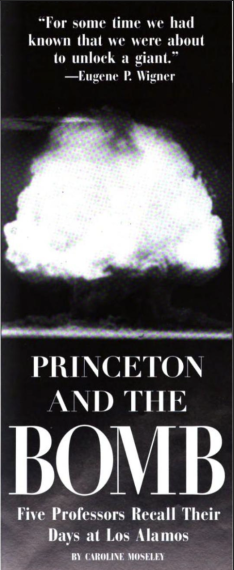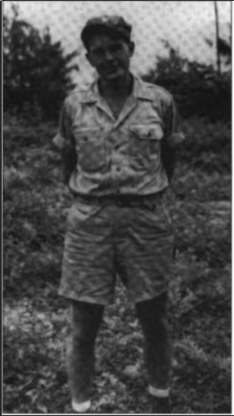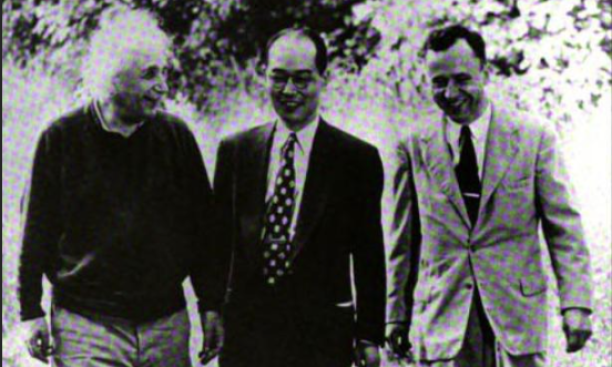
The July 16th blast culminated three years of research by an international community of scientists, many of them Princetonians. It was at Princeton that American scientists first learned of the feasibility of nuclear fission, the splitting of the atomic nucleus by neutron bombardment, with the attendant release of an enormous amount of energy. John A. Wheeler, who at the time was an assistant professor of physics, brought Belgian theoretician Leon Rosenfeld to a meeting of the physics department’s Journal Club on January 16, 1939. There, Rosenfeld described the recent work of German physicists Otto Hahn and Fritz Strassman, who had observed nuclear fission. The effect of the talk on the Princeton physicists, Rosenfeld said later, “was more spectacular than the fission phenomenon itself.”
Not long after the meeting, Wheeler and the Danish physicist Niels Bohr coauthored a paper on “The Mechanism of Nuclear Fission,” suggesting that fission involved Uranium-235, an isotope that occurs in only 1 part in 140 of natural uranium.
The late Eugen P. Wigner, a Princeton professor of physics and a future Nobel laureate, feared the Hahn-Strassman research meant that Nazi Germany would likely build the first atomic bomb. So on July 16, 1939, he and fellow Hungarian emigré Leo Szilard urged Albert Einstein to write directly to President Franklin D. Roosevelt, alerting him to the possibility of a German atomic weapon.
In a volume of recollections told to Andrew Szanton ’85, Wigner said that Einstein “detested…the Nazi regime,” but as the father of relativity theory, he wasn’t interested in the physics of the atomic nucleus. “Indeed, he thought that all of quantum theory was largely an error. And who knows, perhaps someday Einstein will be proved right on that; though, if so, it has certainly been quite a useful error.”
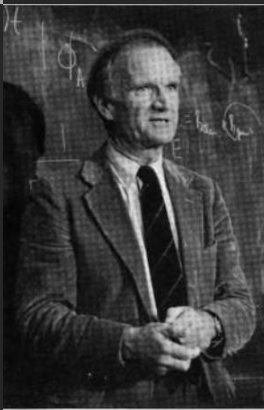
The Manhattan Project built three installations: the Clinton Engineer Works, in Oak Ridge, Tennessee, where U-235 was separated from the more abundant U-238; the Hanford Engineer Works, in Richland, Washington, where nuclear reactors designed by Wigner produced Plutonium 239 from U-238; and the Los Alamos Laboratory, to which the fissionable uranium and plutonium were ship-ped, and where the bomb was designed. Many Princeton faculty members, graduate students, and alumni contributed to these enterprises, and Henry DeWolf Smyth, the wartime chairman of the physics department, wrote the first book-length account of the Manhattan Project: Atomic Energy for Military Purposes, published in late 1945 by Princeton University Press.
The researchers gathered at Los Alamos was a Who's Who of mid-century physical science. Along with laboratory director J. Robert Oppenheimer, who later directed the Institute for Advanced Study, in Princeton, the researchers included Arthur H. Compton, George B. Kistiakowsky, I. I. Rabi, Felix Bloch, James Chadwick, John von Neumann, Hans Bethe, Enrico Fermi, Niels Bohr, Emilio Segrè, and Edward Teller. Along with the famous was the infamous spy Klaus Fuchs, who in 1950 would be sentenced to prison for passing atomic secrets to the Soviets while at Los Alamos. A naturalized member of the project's British delegation, Fuchs was "a quiet, pleasant man," according to Pat Sherr, the wife of one of the Princetonians on the base. "In fact, he babysat for us.”
The A-bomb developed at Los Alamos worked by implosion. That is, chemical explosives on the outside of a sphere compressed a fissionable plutonium core; at the same instant, neutrons were introduced into the core to start a reaction. No one knew whether "The Gadget," as it was code-named, would work. Or whether it would work too well, igniting the atmosphere.
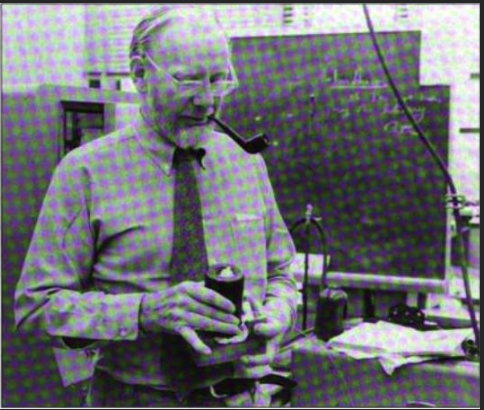
Here are their recollections of an achievement that, fifty years ago, changed the world forever.
THE TECHNICIAN
VAL FITCH WAS AN ENLISTED MAN IN THE ARMY IN 1943, when he was sent to work at Los Alamos as a member of the Special Engineer Detachment (S.E.D.), a group assigned to assist Manhattan Project scientists. He became part of "a very small group" headed by British physicist Ernest W. Titterton. "There was just Titterton, myself, another SED, and two civilian technicians who wired up circuits for us," he recalls. "One of our tasks was to measure the degree of simultaneity of detonation of explosive lenses on the implosion device. Simultaneity was necessary so the plutonium would be uniformly compressed."
At Los Alamos, Fitch met "a lot of very talented people, both the SEDs and the scientists. Being able to work with them seemed to me a remarkable opportunity." In addition to enjoying "unbounded intellectual activity," Fitch realized he was "very lucky to have this as my Army experience. Many people I knew were off doing the difficult things in Europe and the Pacific."
The assembled scientists and technicians "worked very hard, but we had a lot of fun, too, mostly self-generated. For instance, we made a ski slope our-selves, and built a rope tow." On one occasion, Fitch was reprimanded by Enrico Fermi for inadequately filling in the sitzmark from a ski spill, a contretemps the young Fitch considered "mite an honor than a rebuke."
In April 1945, the Titterton group transferred operations to the Trinity site. The high desert of New Mexico was "not the most hospitable terrain,” according to Fitch, who spent his days “biting sand” and setting up devices to take measurements on The Gadget. To test the recording instruments, "we set off a 100- ton charge of TNT, which looked like a pretty big explosion at the time."
Fitch says that the group's responsibilities on test day, in addition to measuring the simultaneity of lens detonation, were "to provide timing markers to other experiment groups during the last milliseconds before Time Zero, and to send out the signal that triggered detonation." On July 16th, Fitch was in the main control bunker at "$10,000" (10,000 meters, or about six miles, south of Ground Zero), along with Oppenheimer and other "higher-ups." Being an anonymous enlisted man among V.I.P.'s, says Fitch, gave him a lifelong "affinity with individuals present, but outside the spotlight, on historically important occasions."
The last thirty seconds of the countdown operated automatically, so Fitch left the bunker. Prone in the sand, he viewed the blast through a piece of glass from a welding helmet. He still has the glass and uses it to observe solar eclipses.
"The explosion was beyond anything you can possibly conceive," he says. "We’d done the TNT thing, but 100 tons is quite different from 20,000 tons," the equivalent strength of the Trinity device. "There was the brilliant flash of light, the immense fireball rising off the ground into the mushroom cloud. Thirty seconds later came the shock wave, a sudden displacement of the air around you. You could hear the reverberation of sound off the mountains, a rumbling that went on and on and on. The scale of the thing! It’s indescribable—people have tried, but no one has succeeded.”
Fitch, who had lost friends in the war and knew men who were fighting the bitter campaigns in the Pacific, had only one thought: “The war will be over soon, no matter what.”
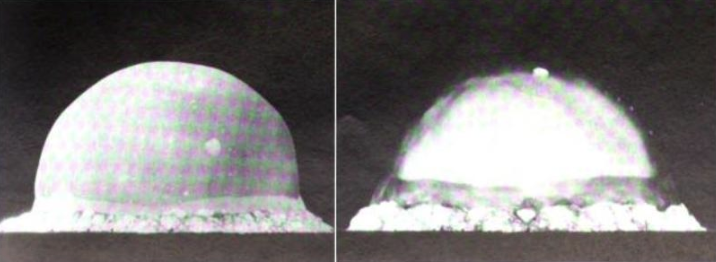
“We each had a good shot,” says Fitch, “and it felt just right.”
THE CHEMIST
IN 1943, WALTER KAUZMANN WAS WORKING WITH THE
National Defense Research Council’s Explosives Research Laboratory, in Bruceton, Pennsylvania, near Pittsburg. The head of the laboratory was George B. Kistiakowsky, a Ukranian chemist who has originally come to the United States to do research under Hugh Stott Taylor at Princeton, but who, according to Kauzmann, “was stolen by Harvard.”
Although Bruceton had "a lot of top-flight chemists," says Kauzmann, after a year and half, he found himself "very depressed. The smog in the winter, from soft coal burning, got me down. I was sick all the time." One day, Joseph Hirschfelder *36 and John Magee, a former research associate at Princeton, appeared in Bruceton, looking for explosives experts to work on an unnamed project in an unnamed location. Both men were deeply sun-tanned. The envious Kauzmann asked, "Where did you find that sun?" The visitors replied, "Somewhere in New Mexico." Kauzmann shot back, "How can I get there?"
Soon, Kistiakowsky approached Kauzmann. "Kisty said, 'I'm going our West. We're working on something even more important than RDX,' a new explosive the military had developed. 'You should come.'
Well, I knew what that something' was, nobody had to tell me. The whole business was secret, but word gets around. Look at Fuchs. He knew everything.
So Kauzmann, a lifelong hiker and camper, headed west, and fell in love with the Rocky Mountains. "If I had to go someplace and stay forever," he declares, "it would be New Mexico. There's such variety in the terrain, from the beautiful alpine scenery to the desert along the Rio Grande." In his spectacular surroundings, Kauzmann worked on the bomb during the day and hiked the canyons of the Jemez Range in the summer evenings.
At Los Alamos he was assigned to an ordnance group developing, he says, "many different aspects" of the explosive technique that would facilitate implosion. I worked on whatever problems came up." He remembers with pleasure lots of intellectual exchange. General Groves wanted secrecy, but Oppy (Oppenheimer] thought people should share information and ideas. It's questionable if the project could have been successful if he hadn't run it that way. He was a fantastic leader."
The labs in the "Tech Area" were well supplied. "When archaeologists dig up Los Alamos," says Kauzmann, "they'll find screwdrivers everywhere, because if you lost one, you didn’t look for it, you just went to the stockroom and got another.
Kauzmann was not among the Trinity test personnel, but he notes that "Don[ald] Hornig, who became chairman of Princeton's chemistry department after the war, was there. His job was to cut the connection with the tower if anything went wrong during countdown."
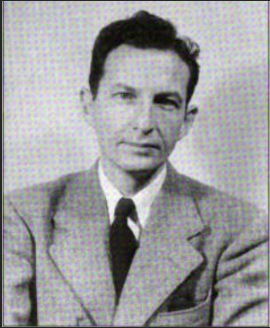
"Suddenly," says Kauzmann, "there was such a light––it's lucky we were looking down at our feet. We looked up, and there was a huge ball, dazzling, brighter than the sun. It expanded and went up into the air, covered with colors. We were aghast. About two minutes later came a crash the like of which I had never heard, followed by fearful rumblings. The sound was more terrifying than the flash." Kauzmann's first thought was, "It worked!" And then. "It didn't set off the atmosphere––which a number of people thought was a real possibility."
Looking back, Kauzmann has "no doubt that we did the right thing" in developing and using the atomic bomb. "If we hadn’t, we might very well have had World War III.”
THE PHYSICIST
RUBBY SHERR LEARNED WHAT WAS HAPPENING AT LOS
Alamos aboard the train that carried him there, in 1944. A researcher in the Radiation Laboratory at the Massachusetts Institute of Technology, Sherr had been summoned to New Mexico by Charles L. Critchfield, one of his former colleagues at Harvard.
"I figured they must be doing something with nuclear power," Sherr recalls. On the train he met Berkeley physicist Luis W. Alvarez. "Alvarez asked me, Do you know what they're working on out there? They’re making a bomb.'" Sherr's reaction was, "I want to go back to M.I.T.! I was concerned about doing the best I could for the war effort. But I was a nuclear physicist, not an engineer, and I didn't see how I could be particularly useful building bombs."
At Los Alamos, Sherr encountered an old friend: the cyclotron (an atom smasher) he had helped build while an instructor at Harvard. " 'Hey,' I said, 'That looks familiar!' They had also shipped out some power supplies from the Princeton cyclotron I worked with when I was a graduate stu-dent." The Harvard machine and Princeton equipment had been rounded up by Robert R. Wilson, an assistant professor of physics at Princeton who headed the cyclotron group and later directed experimental physics at Los Alamos.
But Sherr wasn't destined to work with his cyclotron; instead, his task at Los Alamos was to design the neutron initiator, or detonator, for the bomb—a device that would, at the micromoment of implosion, release neutrons to initiate plutonium fission.
"We'd go out on the mesa to test different designs for the initiator," he says. "The driver assigned to us would just go nuts when he got out on the mesa. Well, any driver probably would. Bur bouncing around out there with a sphere of explosives the size of a basketball in my lap made me very nervous. I've never been an explosives lover, never one to play with firecrackers as a kid. I liked Fourth of July fireworks, but from a safe distance."
On July 16th, Sherr was at Trinity point "S10,000" (10,000 meters south of Ground Zero) as part of a team that "set up devices at different distances to get whatever information we could from the actual blast," he says. At the time of the blast he was in an earth-covered bunker with a six-inch aperture above ground. "Each of us had oscilloscopes-like TV screens-to monitor electrical signals. We needed it to be dark so we could see the 'scope tracings. All of a sudden, there was a brilliant light. I yelled, ‘Who the hell turned the lights on?’ Then I felt very stupid. We’d been following the countdown, so, of course, I knew it was the bomb."
Sherr ran outside to take a look. "My first thought was, 'My God, this is the world's greatest experiment!' And I was relieved that the atmosphere hadn't taken off. Then I thought perhaps it would be better for mankind if it hadn't worked—if nature had been such that it couldn't work." Still, Sherr believes it "was inevitable that the bomb would be invented, and I believe the devastation of Hiroshima and Nagasaki has kept the world from another war."
Not long ago, Los Alamos yielded up a further secret to Sherr. "On the base," he says, "you did your job and didn't ask other people about theirs; you knew only as much as you needed to know. Recently, I met Morris Kolodney, a metallurgist who was our next-door neighbor at Los Alamos. It turns out that his job was to electroplate the initiator. Neither of us knew that in 1945.
"After all," he adds wryly, "Nobody there knew all the details— except Klaus Fuchs."
THE NAVY MAN
IN THE EARLY 1940S, GEORGE REYNOLDS was a graduate student at Princeton, doing defense research with Professor Walker Bleakney on blast effect. He recalls that he "didn't want to spend the war on a campus," and had determined to enlist in the Navy, hoping to be trained as a specialist who cleared amphibious landing sites of obstacles. But while still a civilian, he came under considerable pressure "to work on a 'special project’—and I had a pretty
good idea what it was. somewhere our West.' Nobody ever said 'Los Alamos.' "
Vannevar Bush, the director of the Office of Scientific Research and Development, wrote the university, specifically requesting "Reynolds at Princeton" for "a matter of great importance." In addition, James B. Conant, the head of the National Defense Research Council, summoned Reynolds to his office in Washington, D.C., to urge his participation. Despite the pressure to work on the Manhattan Project, Reynolds enlisted in the Navy in 1944. He may have been the war's only volunteer to be chided by his draft board for not remaining a civilian.
As a graduate student, Reynolds could refuse the western posting. But as Ensign Reynolds, he had to obey. Shortly after receiving his commission, the Navy canceled his orders for amphibious- warfare training and gave him four days to get to a new post in New Mexico.
Once at Los Alamos, he was assigned to a group responsible, he says, for "the electronics to fire the implosion charges on 'Fat Man,' the bomb that was dropped on Nagasaki," on August 9th, three days after the Hiroshima blast. Because of his expertise in predicting both air blast and ground shock from explosions, he also worked closely with Kenneth T. Bainbridge, the Trinity director, to select an appropriate site for the test. His task was complicated by his inability to gain access to a highly classified report that he himself had prepared while at Princeton. Fortunately, his wife, Virginia, worked in the Los Alamos documents room, and "just brought the report home."
As one of only three Navy personnel on the base, Reynolds recalls feeling "very visible." One night he was returning from the Tech Area, thinking about his laboratory work, and walked past what turned out to be the base commander without saluting. The next day, he was summoned by his group leader, William Parson, a naval captain who "knew I was unhappy about not being in amphibious warfare. The captain merely said, "I know it is not very satisfactory for a naval officer to be fighting the war at 7,300 feet, but we must obey certain conventions."
For rest and recreation at Los Alamos, there were weekly movies, dinner parties made possible by the guests' pooling their ration cards, and outings to nearby canyons, some with dwellings of the Anasazi, Native Americans who had lived there a thousand years before.Reynolds also played the violin in occasional quartets and quintets, once with Klaus Fuchs and once with Edward Teller, who "used his artificial leg to pound out time on the floor. I still feel sorry for the family living below him."
By June 1945, Reynolds was "ready with our part of the Fat Man." Some of his group went to Tinian, the small island in the Marianas where the Hiroshima and Nagasaki bombs were to be assembled, and from which the B-29's carrying them would take off. Reynolds stayed at Los Alamos, awaiting the results of the Trinity test. "If it failed, we'd just get back to work," he says. "If it succeeded, I would leave immediately for Tinian. Which is what happened."
While on Tinian, Reynolds and another Los Alamos man, a lieutenant, were slated for the Nagasaki mission "to monitor the firing circuits. Then a V.I.P. arrived who wanted the glory of being on the flight." There was still one spot left. Reynolds and the lieutenant, after learning each other's protocols for the flight, drew lots. Reynolds lost, and the plane took off without him.
Within days of the Nagasaki bombing, "the war ended, and everyone got to go home, except me," recalls Reynolds. He remained on Tinian until the beginning of the occupation of Japan, then embarked on a mission to assess bomb damage in Tokyo, Yokohama, Hiroshima, and Nagasaki. Finally, "My war—and I had an easy war––was over in March, 1946.”
THE VISITOR
JOHN WHEELER WAS AN OCCASIONAL VISITOR AT LOS
Alamos in the period before the Trinity test. On leave from Princeton, he had joined the Metallurgical Laboratory at the University of Chicago immediately after Pearl Harbor to work with Enrico Fermi on developing a nuclear reactor. *I didn't have a clear vision of a bomb," he says, until our British friends pointed out that making a nuclear reactor was not going to win the war—you couldn't drop a reactor."
Most importantly, Wheeler was "house physicist at the Hanford Engineer Works, the plant that produced the plutonium to ship to Los Alamos. He describes his function as "thinking of everything that could possibly go wrong. I was somebody who looked under the bed for things."
E. I. du Pont de Nemours, of Wilmington, Delaware, built and operated Hanford, which received its scientific direction from the Chicago laboratory. So Wheeler "went back and forth once a week from Wilmington to Chicago, and once a month from Wilmington to Han-ford. By train, naturally. You'd leave Friday afternoon from Wilmington, you'd go through some beautiful country, and Monday morning you'd be in the State of Washington.”
He remembers his first visit to Los Alamos. "1 was on the Great Northern route going out of Minnesota, just coming into Fargo, North Dakota, when someone came through the train calling my name. There was a telegram for me, telling me to get off the train, go back to Chicago, and from Chicago to Los Alamos."
The reason for the detour, says Wheeler, was “concern about safety at Hanford.” He’d been ordered to consult at Los Alamos with his former student (and a future Nobel laureate), Richard Feynman *42. "We were worried about too much plutonium accidentally coming together," Wheeler recalls. "Would it go off? Would the whole chemical-processing area be knocked out of commission? The point was, how much plutonium was a safe amount? Feynman figured that out for us." Back at Hanford, comfortable with Feynman's calculations, "We decided we didn't need to build another $200 million plant, just in case the one plant blew."
Wheeler remembers Feynman, one of the most Wheeler was at Hanford when word reached him of the Trinity blast. "I was elated that it worked," he says. "Though many lives were lost, many lives were saved by using the bomb. Some people had the idea that we should have just had a demonstration, but that wouldn't have been effective. This way, we ended the war quickly and deterred Soviet aggression."
His only regret is that "we could have started earlier, made a bigger push. We could have saved more lives." Wheeler's brother, Joe, had joined the Army and was killed in October 1944 while fighting in Europe. "My brother had written me from the Italian front to 'Hurry up!'" he says. "But we weren't in time."
This was originally published in the June 7, 1955 issue of PAW.

